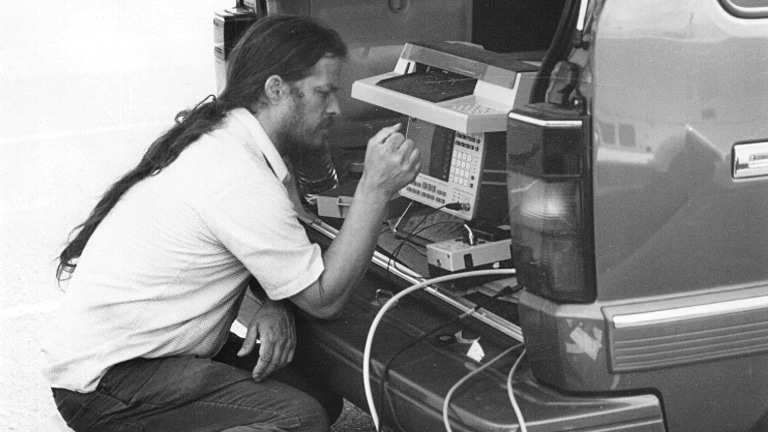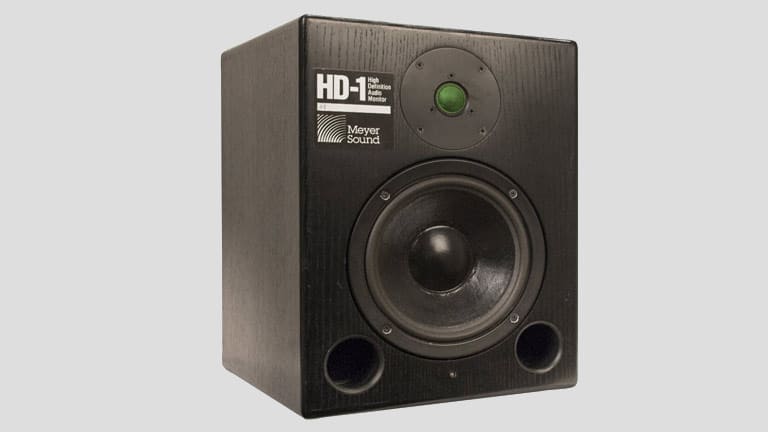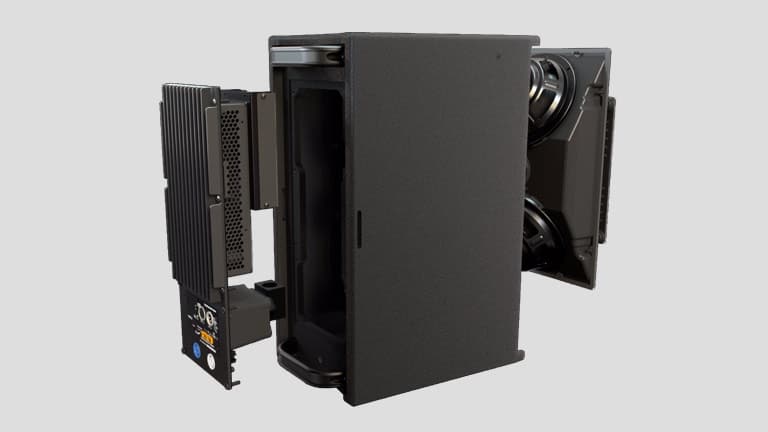| Part Number | 79.246.025.01 |

The 900-LFC Low-Frequency Control Element extends the response of mid-sized P.A. systems to 35 Hz, revealing the nuances of your mix, down to the deepest bass with total accuracy.
Take advantage of the linearity and fidelity of the flagship 1100-LFC, in a smaller, lighter package that’s ideal for scalable systems. Whether you’re in a club, theatre, theme park, or on tour, the 900-LFC delivers breathtaking bass, from the front row to the back of the house.
Crank it up with confidence: The 900-LFC’s ultra-efficient Class-D amplifier delivers high peak power with minimal distortion, for the utmost clarity and crisp transients at any volume level.
Hassle-free hardware options, including QuickFly rigging, give you complete coverage control. Use multipurpose grid kits to fly or ground-stack boxes, in standard or cardioid orientation, and in curvilinear or line arrays. Fly the 900-LFC alone or with LEOPARD, or integrate with ULTRA Series loudspeakers using its built-in pole-mount receptacle.
A Partner for Any P.A.With a 31 to 125Hz range, the 900-LFC is ideally matched to LEOPARD arrays, and integrates easily with LEO, LYON, and ULTRA Series, as well as the 1100-LFC. | Self-Powered SimplicityThe 900-LFC’s active design means no struggling with amp racks, long cable runs, or gain and crossover calibration—saving you time and money with every load-in and teardown. | Rugged and RoadworthyThe 900-LFC is built tour-tough with a durable multi-ply hardwood cabinet, hex-stamped steel grille, protective plastic skids, and weather-protection options. An optional caster frame lets you securely transport stacks of three. | A System at Your FingertipsFine-tune the 900-LFC’s performance with pinpoint accuracy, using Meyer Sound’s powerful software options: Optimize system design with MAPP 3D system design and prediction tool, Galileo GALAXY loudspeaker management, and monitor in real time with RMS remote monitoring. |
A Partner for Any P.A.With a 31 to 125Hz range, the 900-LFC is ideally matched to LEOPARD arrays, and integrates easily with LEO, LYON, and ULTRA Series, as well as the 1100-LFC. | |
Self-Powered SimplicityThe 900-LFC’s active design means no struggling with amp racks, long cable runs, or gain and crossover calibration—saving you time and money with every load-in and teardown. | |
Rugged and RoadworthyThe 900-LFC is built tour-tough with a durable multi-ply hardwood cabinet, hex-stamped steel grille, protective plastic skids, and weather-protection options. An optional caster frame lets you securely transport stacks of three. | |
A System at Your FingertipsFine-tune the 900-LFC’s performance with pinpoint accuracy, using Meyer Sound’s powerful software options: Optimize system design with MAPP 3D system design and prediction tool, Galileo GALAXY loudspeaker management, and monitor in real time with RMS remote monitoring. |

The 900-LFCs have such great punch for a compact box. With the subwoofers we had used before we would sometimes get only a muffled rumbling for low-frequency effects. But with the 900-LFCs, the low transients are clearly defined. It’s obviously a faster loudspeaker.”
Mark OppedijkAukes Theatertechniek (Openlucht Film Festival, Netherlands)
Both the 1100-LFC and the 900-LFC sound fantastic, with unbelievable detail. Also, the new 900-LFC provides a lot of flexibility in theatre applications due to its modularity.”
Mick PotterSound Designer, School of Rock (London)
The low-end directivity of the 900-LFCs is amazing. It reduced the spill a lot and made it easy to control the resonant frequencies of the room. The whole system sounded completely natural. What went in came out; everything sounded exactly like it should.”
Björn WiesehöferSystems Engineer, Contour (Moers Festival, Germany)
The system can fool me into thinking the sound is not really amplified, even though I know it is—that feels like magic.”
Andrew DubowskiOperations Director, San Francisco Symphony
Meyer Sound has been pioneering self-powered loudspeakers for professional installations and touring since 1995. We’ve committed to self-powered systems because we know they deliver unrivaled clarity, reliable performance, value, and ease of use.
If you’ve been thinking about investing in a self-powered system, you’ve come to the right place.

The story of self-powered loudspeakers is in many ways the story of Meyer Sound itself.
In the 1970s, sound reinforcement technology was inconsistent science at best, and at worst, led to show-ending failures. A young John Meyer, designing loudspeakers for San Francisco’s McCune Sound Service, wanted to bring quality and reliability to sound systems, and he knew the answer lay in self-powered loudspeakers. In 1979 Meyer founded his own speaker company; early Meyer Sound innovations include the iconic HD-1 self-powered studio monitor launched in 1989.
Today Meyer Sound offers a full range of self-powered sound reinforcement products. Meyer Sound systems can be found on tour with artists ranging from Ed Sheeran to Metallica, on Broadway and London’s West End, and in performance venues from the San Francisco Opera to the Vienna Philharmonic not to mention sports stadiums, cruise ships, and houses of worship around the world.

Self-powered loudspeakers offer several advantages over their passive counterparts when it comes to fidelity, reliability, and simplicity. The great part is, you’ll start to reap the benefits of a self-powered system before you even power up.
Ease of deployment: System set-up is so much easier when you have fewer components and fewer cables to worry about being miswired. Since self-powered loudspeakers incorporate amplification, you’ll never have to deal with matching speakers to amplifiers or connecting components. You don’t have to worry about calibration of gain and crossover setting which means more time focusing on the show. Eliminating amp racks doesn’t just streamline system deployment, it streamlines your inventory whether you’re a rental house or a road warrior. And when you consider that the average amp rack weighs nearly 300 pounds and takes up four feet of truck space, the efficiencies get even clearer. Let alone when you want to fly the amplifier racks to get closer to the speakers, often requiring more rigging points and more motors.
Predictable, reliable operation: Internal amplification is closely matched to drivers. Because individual components have been optimized during manufacturing, you can expect consistent sound from show to show. Built-in, factory-optimized protection circuitry provides extra assurance without degrading signal quality. And, when you have less equipment, you have less risk of failure.

Better frequency and phase response: Because self-powered loudspeakers incorporate sophisticated processing, they are calibrated to exhibit optimal response curves in key performance parameters. Active crossovers are more precise, sophisticated designs, and bi-amped systems are time aligned, eliminating phase issues. The result? Accurate sound throughout the speaker’s range, at any volume level.
Unparalleled clarity: In powered monitors, internal amplifiers are precision-matched to drivers, delivering optimal power at all times for cleaner sound. And because amps are built into loudspeaker cabinets, there’s no need for long lengths of connecting cable, which can become prone to distortion and signal loss.
Tighter transients: Since self-powered loudspeakers have very short internal cables, amps inside can more effectively dampen driver mechanical motion, which leads to better sonic accuracy and tighter, crisper transients. (And, there’s none of the loss in levels and signal quality inherent over long cable distances.)
Certified Safe: Nothing matters more than the safety of your staff and customers. Because self-powered loudspeakers incorporate amplification, they must undergo rigorous testing by Underwriters Laboratories and other international organizations to ensure they operate safely and guard against the risk of fire, electric shock, and inadequate structural design. Enjoy peace of mind knowing Meyer Sound powered products are certified by FCC, UL, CSA, CE, and CEE the most stringent agencies in the business.
What about passive loudspeakers? At first glance, passive systems may seem like a bargain. But we already know that passive systems require more components and accessories than powered systems. Sonically, they exhibit potential for signal loss over distances, and it is very hard to ensure consistent, optimal sound and volume as amplifiers have many variables to consider when being matched to loudspeakers, such as cable lengths and gauge as well as the number of speakers connected to the amplifier.
Passive systems are often touted as easy to service. But because powered loudspeakers are so complex to design and build, self-powered loudspeakers usually represent the top innovations from leading manufacturers. Better quality translates to better reliability, which means fewer maintenance issues in the long run.
At face value, passive systems might seem less expensive and easier to maintain. But once you start adding in amps, cables, and other components not to mention increased transport and labor costs you’ll find that those savings just don’t add up to a better value.
Once you recognize all of the advantages inherent in self-powered loudspeaker systems, it’s easy to understand why the world’s top venues and productions rely on them to deliver consistently stunning sound.

| Part Number | 79.246.025.01 |

| Part Number | 79.246.026.02 |
| Part Number | 40.010.973.01 |